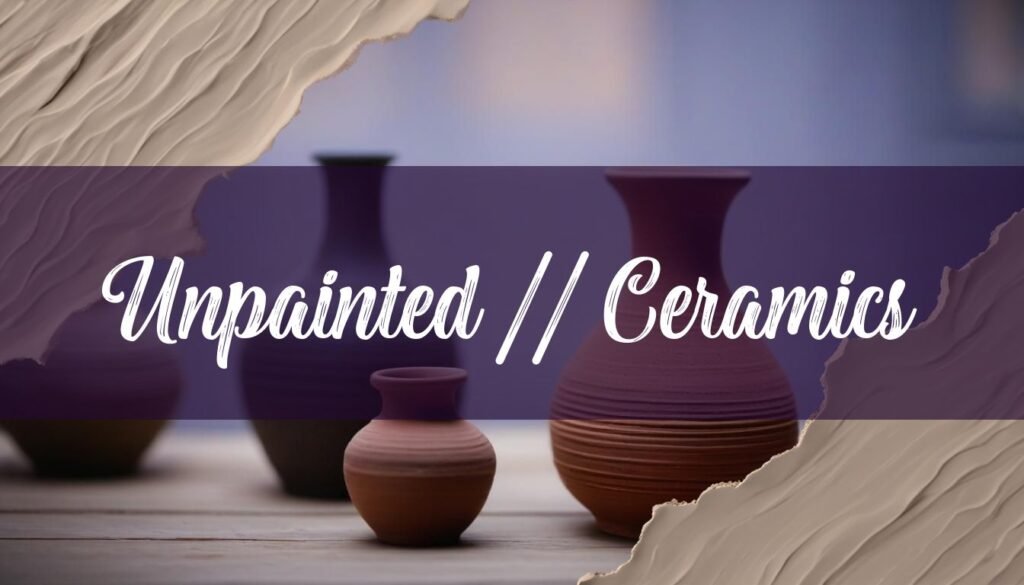Unpainted ceramics, often referred to as bisque, offer a fantastic canvas for creativity, allowing artists and hobbyists to personalize a wide array of items from figurines to functional tableware. Whether you’re a seasoned ceramicist or just starting out, understanding where to source quality bisque is essential for a successful and enjoyable painting experience. This article explores the various avenues for purchasing unpainted ceramics, weighing the pros and cons of each to help you make the best choice for your artistic endeavors.
Where to Buy Unpainted Ceramics
Several options exist for acquiring unpainted ceramics, each with its own advantages in terms of selection, price, quality, and convenience. Local ceramic studios, online retailers, craft stores, and wholesale suppliers each cater to different needs and preferences.
Local Ceramic Studios:
Local ceramic studios are a treasure trove for those seeking unpainted ceramics. These studios often create their own bisque or source it from reputable manufacturers, ensuring a certain level of quality. The advantage of buying from a local studio extends beyond the product itself; it includes the opportunity to connect with fellow ceramic enthusiasts, receive expert advice on painting and firing techniques, and sometimes even participate in workshops. However, local studios might have a limited selection compared to larger retailers, and their prices might be slightly higher to account for their specialized services. Despite these potential drawbacks, the personalized service and community aspect make local studios an excellent choice for those seeking guidance and inspiration.
Online Retailers Specializing in Ceramics:
Online retailers specializing in ceramics offer an extensive selection of unpainted bisque, often far surpassing what you might find in a local store. These retailers typically provide detailed product descriptions, customer reviews, and a wide range of options from various manufacturers. Dick Blick and The Ceramic Shop are great places to start when searching online for ceramic bisque. The convenience of online shopping, with the ability to browse and purchase from the comfort of your home, is a major draw. However, it’s essential to carefully review the retailer’s return policy and shipping costs, as these can significantly impact the overall cost. Additionally, you miss the tactile experience of examining the bisque in person, so reading reviews and understanding the product specifications becomes even more important.
Craft Stores with a Ceramics Section:
Large craft stores like Michaels or Hobby Lobby often have a ceramics section that includes unpainted bisque. These stores are convenient for those who need to pick up other art supplies at the same time, and they frequently offer discounts and coupons. However, the selection of unpainted ceramics in craft stores is typically more limited compared to specialized ceramic retailers, and the quality might vary. The staff may also lack the specialized knowledge found in ceramic studios, so it’s crucial to do your own research and carefully inspect the bisque before purchasing. Despite these limitations, craft stores can be a good option for beginners or those looking for basic bisque shapes at an affordable price.
Alternatives: Wholesale Suppliers:
For those planning larger projects or running a paint-your-own-pottery business, wholesale suppliers can be a cost-effective option. These suppliers typically offer significant discounts for bulk purchases, but they may require a business license or minimum order quantities. While the selection is often vast, the focus is usually on standard shapes and sizes. Quality can vary, so it’s important to research the supplier and request samples before committing to a large order. Wholesale suppliers are ideal for those with a clear understanding of their needs and the ability to handle larger volumes of bisque.
Choosing the Right Bisque and Preparing for Painting
Selecting high-quality bisque is crucial for achieving the best results in your ceramic painting projects. Look for pieces that are smooth, free from cracks or chips, and evenly fired. The type of clay used, whether earthenware, stoneware, or porcelain, will affect its properties and best uses. Earthenware is a low-fire clay that’s easy to paint and glaze, while stoneware is more durable and suitable for functional items. Porcelain, known for its delicate appearance and high firing temperature, is often used for more refined pieces. You can learn more about the different types of clay used for ceramics in our guide.
Before painting, clean the bisque with a damp sponge to remove any dust or residue. Depending on the type of paint or glaze you plan to use, you may need to apply a base coat or sealant. For underglazes, apply one to three coats for the desired opacity, and then fire to cone 06. Remember to use non-toxic, lead-free materials, especially for items intended for food or drink. Acrylic paints can also be used for ornamental pieces, offering a wide range of colors and effects, but they are not suitable for items that will come into contact with food or water.
Essential Tools and Equipment
Painting and glazing unpainted ceramics requires a few essential tools and equipment. Brushes in various sizes and shapes are crucial for applying paint and glaze evenly and creating detailed designs. Sponges are useful for creating textured effects or blending colors. A palette is necessary for mixing colors, and a glazing fan brush is ideal for applying clear glazes smoothly. Other helpful tools include stylus tools, sponges, and ceramic tool kits. Safety gear, such as gloves and a mask, is important when working with glazes and firing your pieces in a kiln. Having the right tools will not only make the process easier but also enhance the quality of your finished pieces. For information on what paint to use on ceramic, check out this article.
Firing Temperatures and Processes
Understanding the firing process is crucial for achieving successful and safe results. Bisque firing is the initial firing cycle that converts clay into a permanent ceramic material. Most clay bodies are bisque fired between Cone 08-04, which equates to about 1650-1945°F. The exact cone you choose depends on the clay type and desired properties. Higher bisque temperatures make the clay denser and less porous. In low fire, the bisque temperature is usually hotter than the glaze firing temperature. For example, most commercial glazes recommend bisque firing to Cone 04 and glaze firing to Cone 06, which is cooler. This ensures that all the carbon and other materials in the clay burn out during the bisque firing. Always refer to the labels of your glazes and clay to confirm temperature requirements. Firing too high can deform or melt the clay, while firing too low can result in dry, rough, and unsolidified pieces.
With the right bisque, tools, and knowledge, the possibilities are endless. Whether you’re creating personalized gifts, unique home décor, or functional tableware, unpainted ceramics offer a rewarding and expressive medium for your artistic vision.





